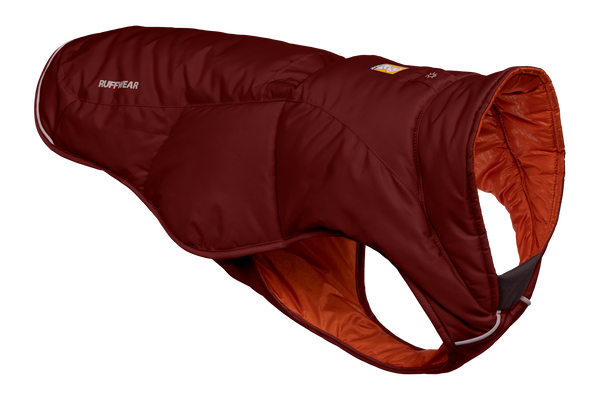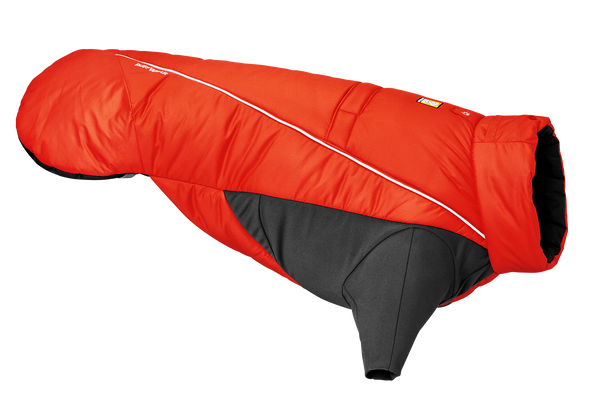Sustainability Update: Chemicals Management at Ruffwear
We checked in with Kelly Hughes, Ruffwear's Sustainability Program Manager to learn about the chemicals management process at Ruffwear. And, most importantly, how it's our responsibility to use chemistry wisely to protect our consumers, supply chain partners, and the ecological systems in which our manufacturing facilities are located.
What does chemistry have to do with my dog’s gear?
Fortunately and unfortunately, your dog’s gear is chemistry. From the Polyoxymethylene in the buckle on your dog’s Flat Out™ Collar to the dyes that made that sweet, sweet Huckleberry Blue color of your dog’s Front Range® Harness – the look, feel, durability, and performance of Ruffwear gear is all directly related to chemistry.
And sometimes, really great looks, feels, durabilities, and performances can come from really nasty chemistry.
At Ruffwear, we believe we have a deep responsibility to use chemistry wisely in the production of the materials we design into our gear. And here’s the really important part: that responsibility is not just to you (our end-consumer community of pawesome explorers), it’s also to our supply chain partners that work with the chemicals directly, as well as the ecological systems in which the manufacturing facilities are located.

Here’s a stat that grabbed my attention early on in my sustainability career and has never let go:
Only about 10% of the chemistry in any textile-based consumer good actually makes it through to the end-product.
Let that sink in for a moment. This means that roughly 90% of the chemistry is either: a) emitted to the atmosphere through the air, b) disposed of, c) exited from the production facilities by way of wastewater, OR, ideally d) is captured on-site and recycled back into new production.
But recycling chemicals is not always possible for a wide variety of reasons, and even if it were, we’d still hold the responsibility of making choices for our products that are also good choices for the health of every person along the supply chain.

So, how does Ruffwear address this responsibility?
First, we find credible sources of information, absorb/digest that information, and then we figure out how to use our increased awareness to make better decisions about our products and the way we run our business. And then we do it all over again, again, and again.
The Chemicals Management Program at Ruffwear can be summed up in three bullet points:
- Develop good sourcing relationships with trusted partners who align on chemicals management as a business priority
- Implement and maintain an appropriate and thorough Restricted Substance List within the supply chain, including an adequate testing program to validate its conformance
- Select, or develop, responsible materials

Sourcing Relationships
Material and finished goods suppliers are vetted by a cross functional team (including voices from product development, sustainability, and supply chain) before the vendor relationships begin. From the sustainability perspective, determining a prospective supplier’s prowess and willingness to progress in the area of chemicals management is important to address early on.
Thus, in combination with Ruffwear’s Code of Conduct for Suppliers, a Chemicals Management Agreement leads these conversations. This agreement is a simple statement of our chemical standards and policies, and includes:
- An agreement to comply with all applicable chemical regulations in the global market, most notably EU REACH SVHC, CA Prop 65, and EU RoHS
- An agreement to conform to the AFIRM RSL (Ruffwear’s chosen industry standard restricted substance list)
- Additional, specific policies on certain chemistries: no PVC, no BPA, and a cease of manufacture with all intentionally added PFAS by 2024

Restricted Substance List (RSL) Testing Program
Every quarter, we send a subset of our finished materials to an accredited third-party lab (as in a laboratory, not a labrador) where they undergo chemical analyses.
Specifically, we are testing to assess whether or not any of our products, or their input materials, include substances in quantities beyond the allowable limits outlined in the AFIRM RSL that our suppliers have agreed to uphold by signing our Chemicals Management Agreement.
The subset of finished materials that are submitted in any given quarter is determined through a combination of factors:
- The AFIRM RSL Testing Matrix (pages 13-15) – a table outlining the level of risk of chemical substances/substance groups according to the material type
- The prioritization of the materials based on their consumption rates – i.e., materials we consume in the greatest volumes are prioritized for testing over materials we consume in small volumes
- The prioritization of the materials based on our own risk assessment – bluesign® approved materials are low risk and therefore deprioritized, and new materials are prioritized over materials that have a long and clean testing history
- Weighing the options: rotation of materials to ensure good breadth of coverage vs. building historical compliance data through repeated testing (both approaches have their advantages)

After the lab completes the testing for all materials sent, they send us a test report summarizing the findings. We check it for the following:
- Any RSL nonconformities (i.e., any substances found in concentrations above the limits outlined in the AFIRM RSL)
- Any potential violations to global regulations (i.e., any substances detected at concentrations above the legal limits outlined through a number of global regulations such as the EU REACH SVHC)
If (A) occurs, the supplier of the material is immediately notified of the nonconformance and collaborative effort ensues to identify the root cause and the best solution. After quick remediation of the RSL failure, the supplier must prove the material is back in compliance through another round of RSL testing of their material.
If (B) were to occur, immediate halt in production and recall of all affected products would be warranted. Luckily, Ruffwear has not encountered this, but the risk of liability underlines the value of developing strong sourcing relationships with reputable suppliers from the beginning.

Responsible Material Selection
Ruffwear nominates nearly all key components of our products (fabric, webbing, hardware, insulation, foam, etc.), and wherever possible, nominates those components as bluesign® approved. To learn more about the bluesign® system and why Ruffwear is a system partner, check out this page.
Material nomination means that the brand is responsible for developing the material in collaboration with the chosen material supplier, and communicates the specifications of the developed material to the finished goods manufacturer.
An alternative form of material sourcing happens when the brand gives the responsibility of material development to the finished goods manufacturer who will then work with their sub-suppliers to create a material meeting the brand's needs.
One is not necessarily better than the other, and oftentimes both types of material sourcing are necessary, but the former method gives the brand more control over who is in their supplier network and, when done successfully, can also minimize the risk of violations (not just chemical, but other environmental and social violations as well).

Ruffwear’s nomination of most materials has the added benefit in this context of being able to leverage that direct relationship with the material supplier to prevent or remedy all RSL issues.
During the partnership discovery phase, while the product development team assesses the supplier’s material palette and capabilities, the sustainability and sourcing teams assess other aspects that lend to a good sourcing strategy.
And if anything goes wrong down the line, such as an RSL failure, the direct relationship of brand-material supplier will oftentimes lead to faster responses and more collaborative work than if the communication had to happen through the finished goods manufacturer.

When it comes to chemicals management practices, a valid bluesign® certification indicates that the supplier is one of the lowest risk options.
Ruffwear still communicates our chemicals management policies to bluesign® certified facilities, still communicates our intention to purchase bluesign® approved versions of the nominated components, and still tests bluesign® approved materials through our RSL testing program (at a lower cadence than non-approved materials).
The rigor of the bluesign® certification process, however, affords us a high level of confidence when entering into a new sourcing relationship.

In lieu of a bluesign® certification/system partnership, OEKO-TEX Standard 100 certifications and Global Recycled Standard (GRS) certifications can both provide some confidence that a supplier has a proven track record of chemical compliance.
At Ruffwear, however, these types of certifications would not lead to deprioritization of the materials in our RSL testing program because we do not have deep knowledge and trust of the chemicals management elements of the certification processes like we do with the bluesign® system.
Consumer Influence for Better Chemicals Management Practices
Though the responsibility for good chemicals management practices falls on the brand (and likewise on the suppliers in their network), retail customers and end-consumers can influence the industry to embrace better practices and more rigorous standards.
Ask your favorite brands to share their restricted substance list with you. Look for labels like bluesign® approved, and let them know that high chemical standards mean something to you as a loyal consumer. We are proud to have engaged and educated consumers in our community that have fueled a more formalized approach to chemicals management here at Ruffwear.
Interested in learning more about Ruffwear's sustainability efforts? Check out more stories here.


















